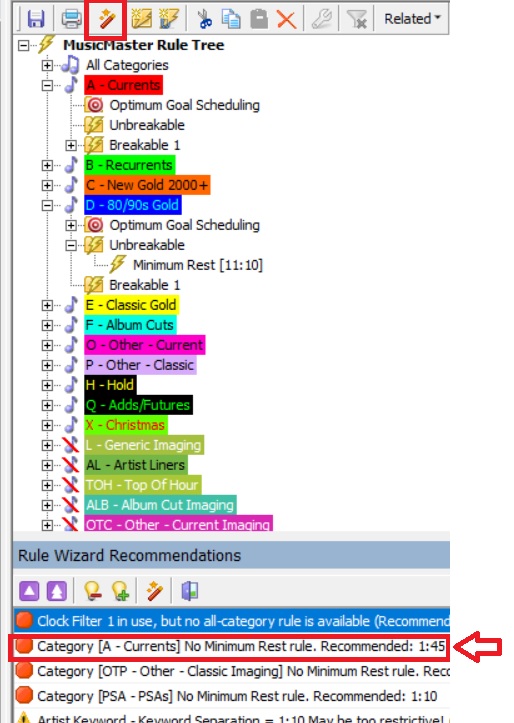MusicMaster Blog
Song Rest: Rules or Goals? posted on April 5th, 2021
Song Rest: Rules or Goals?
By Dave Tyler
We are all aiming for good, even rotations. We want all songs in our categories to play. It feels good when you look at the History Graph and see those beautiful patterns filling the day.
The starting point for this is song rest. If a song was not required to rest it would always be available to schedule and this could lead to potential problems. We all have those wonderful medium-tempo, feel good songs that are easy to schedule. If the song happens to be a one-hit wonder then it is even easier to schedule because Artist Separation is never a problem either. Without song rest, you could have a one-hit wonder scheduling more than a core artist. On the other end of the scale, you have songs that are more difficult to schedule. This might be because they are a fast or slow tempo or have a lot of featured artists on them causing Artist Separation rules to constantly fail.
Song Rest can help with these concerns. MusicMaster offers several ways to manage rest. Minimum Rest allows you set a custom time for a category so songs that have been scheduled sit on the bench and allow the other songs in the category to play. I love using the word “Churn” to describe this process. As the category churns we get to hear the entire category.
Setting a Minimum Rest rule requires some important math and is not something you just set off the top of your head. I don’t know about you but I know for sure math was not present on my list of why I want to be in radio! MusicMaster has several ways to find the right number. In your MusicMaster Rule Tree you can click on the magic wand icon and activate the Rule Wizard. This does all of the math you and I don’t want to do! It looks at how many songs are in the category and how many times you are calling for that category in clocks in your active grid and then offers a time that you can use. The brilliance is that the suggested Minimum Rest is only 60% of the slowest average turnover of the category. That means you can put this time in with the highest confidence it will not affect the rotation of a category. Keep in mind if you make changes to your clocks or the size of your categories, these settings need to reviewed and corrected.
Below is a picture showing the Rule Wizard and we can see the time it suggests for the A category. To use this suggestion, I can just double click on it and it will either be added to my Rule Tree or update the existing rule.
You could also click on the Turnover Analysis icon and you will see the suggested Minimum Rest number there as well. Please note in the pic below the suggested rest is different than the one in the wizard but off by a single minute. Both numbers are good. The algorithm used by the Wizard brings the number to the nearest “5” while Turnover Analysis goes to the specific number but again both numbers are spot on!
Using the Turnover Analysis number you would now go back to the Rule Tree and either add the rule from the “Song History Rule” under the available rule types or adjust the existing rule in the Rule Tree.
….but wait there’s more! MusicMaster also pioneered the cutting-edge tool of “Optimum Scheduling Goals”. Unlike a rule that can potentially leave an unscheduled song if no song can be found that passes, Optimum Scheduling Goals search the entire search depth and break any ties with the Optimum Scheduling Goals you’ve chosen. Even better, Optimum Scheduling Goals do all the math for you without reviewing it because it does this every time you schedule.
Here’s a simple overview of how Optimum Scheduling Goals work:
The search depth is reviewed and if there is only one song that meets all of the unbreakable and breakable rules, that song is scheduled. If there are multiple songs that meet this criteria or only songs that break breakable rules, the highest scoring songs are passed on to the Optimum Scheduling Goals to break the tie. A simple example is our Song Rest. What happens when there are multiple songs that all meet the Minimum Rest setting on the Category? Without the Optimum Scheduling Goals, the first song that passed the Minimum Rest rule would be scheduled. With the Optimum Scheduling Goals, it now looks to see if there might be an even better song it could schedule.
Now think about how this might work with the other rules you have in your Rule Tree.
If you have all of your rules for Artist Separation, Coding (tempo, etc.) and Hour Rotation AND you choose to use a Song Rest Optimum Scheduling Goal, MusicMaster make sure these rules are passed and should there be any tie, it will use the Song Rest Optimum Scheduling Goal to break the tie.
If you have all of the above rules as well as Minimum Rest and also included the Song Rest Optimum Scheduling Goal, this has the added benefit of making sure there is some “floor” to your Minimum Rest time and from there, the Optimum Scheduling Goal may come into play to give you even more.
Either way will handle Song Rest. The best one for you really comes down to your programming philosophy and how YOU want to manage or control rest with each category.
As always if you have any questions regarding rules or goals just call your Music Scheduling Consultant and let us help.




